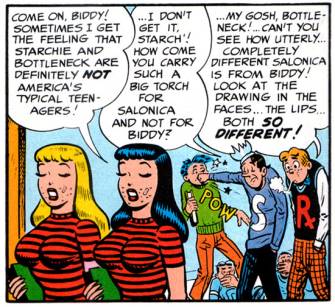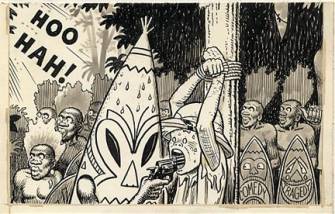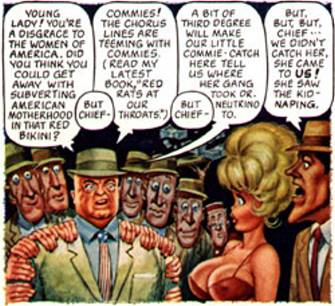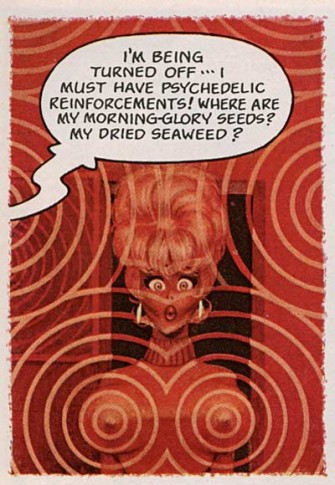
May 16, 2008
 Will Elder, 1921-2008
Will Elder, 1921-2008


Will Elder, one of the great comics illustrators of the 20th Century, passed away early yesterday morning after an extended period of general ill health. He was 86 years old.
Elder was born Wolf William Eisenberg in New York City in 1921. Like many comic book artists of his generation, he attended the
New York High School of Music and Art. He went on to study at the Academy of Design. He joined the US Army in 1942 and as a topographical engineer (map maker) participated in the D-Day invasion of June 1944. Upon returning from service, he founded a studio with one-time Music and Art classmate
Harvey Kurtzman and Charles Stern. His first comics publishing credit dates to 1947. Among the comics talents that worked at or through the Charles William Harvey Studio were
Jules Feiffer,
Rene Goscinny,
Russ Heath and
Dave Berg. The studio would move at least once and close its doors in 1948.

The first half-decade of Elder's long career in comics was distinguished in by a fruitful partnership with John Severin. Elder inking Severin, the pair worked for
Crestwood,
National and
Nedor before joining
EC Comics in 1950. Their lush, muscular comics for
Two-Fisted Tales and
Weird Fantasy are some of the more fondly-remembered comics from that company's prodigious, well-crafted output. Elder also worked with Jack Kamen and illustrated scripts in solo fashion for
Weird Science.

Elder was a founding artist on
MAD, the seminal satirical comics magazine that began in 1952. In a series of parodies, Elder began to make fans take stock of the full measure of his talent: his skill at mimicking fellow artists, his ability to reference fine art in a comics context, the furtive and manic quality of many of his panel compositions including hidden jokes and background humor, and most of all the growing potency of his design skills and illustration chops. The background jokes and gags were likely an influence on a similar approach in a lot of modern film comedies, a mix of visual sophistication and rampant stupidity perfectly suited to the post-television generation. They have been cited as an influence on work from directors as different as Louis Malle and David Zucker. While Elder's "Starchie" may be the most brutal take on a kids-oriented comics to ever appear from a major comics publisher and Elder would experience difficulties later on with work informed by that company's output, it was a parody of
The Night Before Christmas in
MAD companion magazine
Panic that gave Elder his first taste of comics controversy. Objections to that comic resulted in the publication being banned in Massachusetts, one of the more absurd, severe and reactionary examples of 1950s objections to comics content.
"I worked like a b-a-s-t-a-r-d," Elder told Gary Groth in 2003 about this period. "I worked very hard, because not only was I challenged to do something interesting, very interesting, but also to show Harvey that he's got a guy who's doing hard work for him and myself. I was really out to please him, because he never knew I could do that many characters, and accurately." Elder emphasized that each parody brought with it a tremendous amount of effort in terms of nailing down the style. "You know, many people comment on my ability to imitate the style without realizing what I really put into it. I wouldn't expect them to know, but I always had the impression that the fans thought I was up in my studio with a rubber stamp or something, and I was just able to punch this stuff out, but I put in a tremendous amount of time, research and effort in every story I did."

The artist left EC with Harvey Kurtzman in 1956. He worked for the subsequent Kurtzman titles
Trump,
Humbug and
Help!, for which he did a number of significant parodies. He would later say that
Humbug was an effort close to his heart for its policy of returning rights to the authors after first publication. The quality of his work remained quite high, and here he experienced a second career touchstone. Elder was Kurtzman's partner on the
Goodman Beaver series, in which a wide-eyed but infinitely malleable everyman wandered deep into potent, satirical takes on broad cultural subjects. Not only could these be brutally funny attacks on the source material with which they worked, the power of Elder's art guaranteed that they would work as vibrant comics as well. Their Superman parody, "Goodman Meets S*perm*n" remains one of the funniest takes on comics culture but also, especially in a scene where the super-powered character moves a massive rock with alarming precision, one of the more effective evocations of that kind of otherworldly power. A take on the Archie characters in
Goodman Goes Playboy got the creators and their publisher in trouble with the longtime kids' comics publisher both in its original incarnation and one altered for reprint publication. That story became one of the legendary, largely-unseen comics of the 20th Century.

In 1962, Elder again worked with Kurtzman on the launch of
Little Annie Fanny, a long-running and successful feature in
Playboy that continued the
Goodman Beaver formula of satire, only this time with a feeling to the general stories more in line with its glossy, successful home as opposed to the broader, failed satirical magazine start-ups in which
Goodman had appeared. This meant more sexual situations, gender politics, exuberant nudity and commentary on issues of importance to the magazine such as free speech and the role of the media in setting public policy.
Annie Fanny is likely the most successful painted comics effort of all time, and the time-consuming nature of it meant that Elder often drafted artists friends like Russ Heath and
Arnold Roth into helping with its completion.

"We had a studio up in Hefner's loft," Elder told Groth in their 2003 interview. "It was a gigantic place. This was in the mansion in Chicago. We'd sit there and we'd goof off occasionally." Elder would work on 107
Annie Fanny features over the next two and a half decades.
Elder would later join Kurtzman for a brief run in the 1980s
MAD, all the while supplementing the comics with an increasingly successful commercial illustration career. He formally retired in 1988. Elder's reputation in recent years was buoyed by the testimony of several underground cartoonists that cited his work with Kurtzman on the satirical magazines as a great influence on their own work. He was also a favorite of post-underground comics humorists such as
Evan Dorkin and
Dan Clowes. Fantagraphics, planning a
Humbug reprint for later in 2008, published two recent books featuring Elder's work,
Will Elder: The MAD Playboy of Art (2003) and the smaller art book of rarities and doodles
Chicken Fat (2006).
Elder had in recent years suffered from occasional bouts of poor health. He moved into a nursing home in 2005 after the passing of his wife, Jean. Those that enjoyed a personal relationship to Elder were upon his passing as effusive in their praise of his legendary nice-guy status and sweet nature as they were of his prodigious talent. He was inducted into the Will Eisner Award Hall of Fame in 2003.
A private service is planned for Sunday.
 posted 8:25 am PST
posted 8:25 am PST |
Permalink
Daily Blog Archives
November 2019
October 2019
September 2019
August 2019
July 2019
Full Archives


